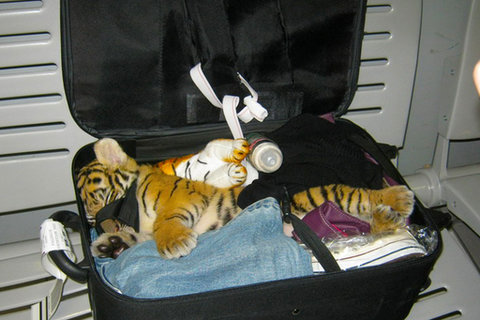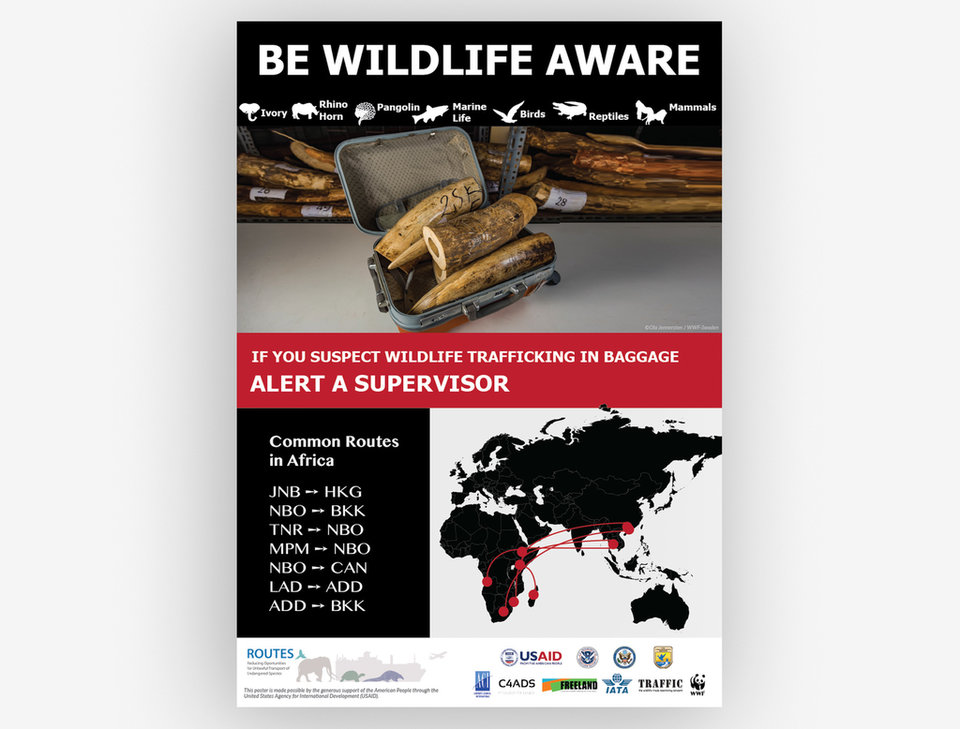SECURITY
Combatting wildlife trafficking through airports
ACI World recently conducted a webinar called ‘Actions airports can take to combat wildlife trafficking’, in which experts spoke about what aviation stakeholders can do to combat the illegal wildlife trade. Frances Marcellin looks at how criminals are still able to smuggle animals and animal goods, and asks what is being done to help airport staff identify wildlife trafficking.
Over the last few years, airports have significantly increased their focus on combating the illegal trafficking of wildlife, fuelled by widespread indifference and organised crime networks. According to the International Civil Aviation Organisation, wildlife trafficking generates between $7bn and $23bn each year, making it one of the largest illicit trade activities in the world.
The global Covid-19 pandemic has also revealed the risk that zoonotic diseases pose when animals are exploited and brought into contact with people, again underlining the critical importance on the need to combat wildlife trafficking. The World Health Organisation says that in the last 30 years, around 75% of new infectious diseases in humans have originated in animals.
To fight this, the USAID partnership Reducing Opportunities for Unlawful Transport of Endangered Species (ROUTES) – which brings together the Centre for Advanced Defense Studies, International Air Transport Association (IATA), TRAFFIC and the World Wildlife Fund (WWF) – produced the In Plane Sight report earlier in 2020, analysing wildlife trafficking around the world through the lens of the air transport industry.
It states that while the fight against the ivory trade has seen its value and trafficking intensity drop, traffickers’ attention has become focused elsewhere. A high-value and complicated trade network now continues for many different species, from rhinos, pangolins, lions and meerkats to iguanas, eels, spiders and hammerhead sharks.
At a recent webinar held by Airport Council International, which looked at the actions that airports can take to combat wildlife trafficking, Rob Campbell of United for Wildlife confirmed that there are half as many animals as there were 50 years ago and that the pangolin is now the world’s most trafficked mammal. Their scales are delicacies in some countries and last year two seizures in Singapore discovered 38,000 smuggled pangolins.
Image:
Smuggling wildlife through global networks
This clandestine network relies on the aviation and maritime industries for trafficking. The problem is global and widespread. After analysing global seizures of wildlife at airports from 2009 to 2017, ROUTES found trafficking had occurred in more than 130 countries worldwide.
In Plane Sight reports that a study in the US found that airport screeners failed to identify banned material 95% of the time. It also revealed that traffickers tend to identify particular airports “for their location, size, connecting flight routes, customs screening procedures and perceived ability to identify contraband, amongst other things”.
The report also states that “large international ports with lax customs screening procedures for trafficked goods, but many connecting flights, are at the highest risk”.

Image:
Elephants are poached for their ivory tusks. Image: ROUTES
The type of seizure depends on where the airport is located and the vulnerabilities of the airport. Almost all of Chennai Airport’s seizures, for example, were reptiles.
African countries are generally classed as the “origin” point where ivory, rhino horn and pangolin goods are traded, whereas In Plane Sight explains that “reptile, bird, marine products and mammal supply chains follow no one clear path, crisscrossing between and within different regions”. Traffickers take advantage of the myriad source regions for the variety of these species.
Airport staff must be trained to notice and report potential wildlife trafficking behaviour. Yet airport staff can also be put at significant risk by the trafficking of venomous animals. For example, at Melbourne Airport in 2017, airport personnel discovered 11 poisonous snakes concealed in a shoebox, six of which were Wagler’s pit vipers from South East Asia.
In Plane Sight reports that smuggled animals can be found in tin foil, hidden compartments in luggage or air freight, abandoned or exchanged luggage, and custom-made clothing. Meanwhile, a poll during the ACI’s webinar showed that 56% of respondents had not yet trained staff or raised awareness regarding wildlife trafficking.
Large international ports with lax customs screening procedures for trafficked goods, but many connecting flights, are at the highest risk
Airports play a key role in combatting wildlife trafficking
In 2016, ACI and other industry partners signed the ‘United for Wildlife Transport Taskforce Buckingham Palace Declaration’. This was followed by the adoption of ACI Resolution ‘Support of the “United for Wildlife Transport Task Force” Campaign’ at the 26th Meeting of the ACI World General Assembly held in Montreal.
United for Wildlife, which is spearheaded by the UK’s Duke of Cambridge, works with airports to help them fight illegal wildlife trafficking. The Buckingham Palace Declaration focuses on raising awareness messages to staff, and airports and airlines can sign up to follow its action plan for combatting the illegal trade.

Tiger cub hidden in luggage. Image © Wildlife Checkpoint Suvarnabhumi Airport
“Species are being hunted to extinction through the illegal killing and trading of wild animals,” said ACI World director general Angela Gittens. “Airports play a key role in this fight.”
The declaration’s objectives include the following: increasing awareness about the scale and consequences of illegal wildlife trade, promoting systems to staff for reporting suspicious activity and improving training.
Species are being hunted to extinction through the illegal killing and trading of wild animals
Educating and empower airport staff
The ROUTES partnership has developed a programme to educate and empower those working in the aviation sector. Training modules, information packs, data dashboards and materials designed to raise airport staff awareness (including role-specific training) are provided cost free to aviation stakeholders.
The goal is to disrupt wildlife trafficking along legal transport supply chains through training airport personnel, as well as improving data analytics, policies and collaboration with enforcement. In addition, a new app is being developed to help aviation and transport staff report suspicious activity.

ROUTES – Be wildlife aware campaign to staff. Image: ROUTES
“So if anybody sees a suspected incident of trafficking, they know the right organisation to report it to, the right agency, who can actually take action against that,” explained Claire Beastall of TRAFFIC in the ACI webinar.
Beastall went on to explain the range of training methods that have been devised, including videos, presentations, role-specific e-modules and toolbox kits for staff that have been created in close collaboration with and approved by ACI and IATA.
“What we’ve produced is relevant to the industry,” said Beastall. “It’s user friendly, ready to use [and] you can just download it yourself,” she said, adding that the general awareness materials are available in English, French, Spanish and Chinese.
The goal is to disrupt wildlife trafficking along legal transport supply chains
Wildlife trafficking in the Covid-19 era
In terms of how the global pandemic lockdown will affect wildlife trafficking, United for Wildlife’s Campbell said there are three main ways global wildlife trafficking will be impacted.
He said that poaching will increase in some key areas due to the network of highly sophisticated organised crime networks; there will be a shift to online selling; and traffickers will focus on proven smuggling routes under increased scrutiny.
While air trafficking will be vastly reduced while the pandemic continues, it is important to be prepared for when the air travel networks start up again.
“Poaching has increased on the back of Covid-19,” said Campbell, adding that fewer tourists and support staff are being taken advantage of by opportunistic poachers. “These are highly sophisticated – or can be – organised crime networks and they will pounce on opportunities like this.”
Poaching has increased on the back of Covid-19